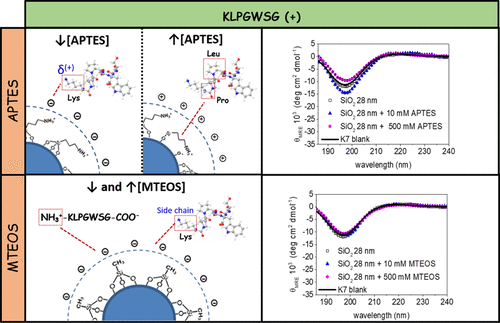Our official English website, www.x-mol.net, welcomes your feedback! (Note: you will need to create a separate account there.)
Interactions at the Silica–Peptide Interface: Influence of the Extent of Functionalization on the Conformational Ensemble
Langmuir ( IF 3.9 ) Pub Date : 2018-06-20 00:00:00 , DOI: 10.1021/acs.langmuir.8b00874 Anna Sola-Rabada 1 , Monika Michaelis 1, 2 , Daniel J. Oliver 1 , Martin J. Roe 3 , Lucio Colombi Ciacchi 2, 4 , Hendrik Heinz 5 , Carole C. Perry 1
Langmuir ( IF 3.9 ) Pub Date : 2018-06-20 00:00:00 , DOI: 10.1021/acs.langmuir.8b00874 Anna Sola-Rabada 1 , Monika Michaelis 1, 2 , Daniel J. Oliver 1 , Martin J. Roe 3 , Lucio Colombi Ciacchi 2, 4 , Hendrik Heinz 5 , Carole C. Perry 1
Affiliation

|
In this contribution, the effect of silica particle size (28 and 210 nm) and surface chemistry (i.e., hydroxyl, methyl, or amino groups) on peptide binding response is studied with a specific emphasis on the effect of the extent of functionalization on binding. Exhaustive characterization of the silica surfaces was crucial for knowledge of the chemistry and topography of the solid surface under study and, thus, to understand their impact on adsorption and the conformational ensemble of the peptides. The extent of surface functionalization was shown to be particle-size dependent, a higher level of 3-aminopropyl functionality being obtained for smaller particles, whereas a higher degree of methyl group functionality was found for the larger particles. We demonstrated that peptide interactions at the aqueous interface were not only influenced by the surface chemistry but also by the extent of functionalization where a “switch” of peptide adsorption behavior was observed, whereas the changes in the conformational ensemble revealed by circular dichroism were independent of the extent of functionalization. In addition to electrostatic interactions and hydrogen bonding driving interaction at the silica–peptide interface, the data obtained suggested that stronger interactions such as hydrophobic and/or covalent interactions may moderate the interaction. The insights gained from this peptide–mineral study give a more comprehensive view of mechanisms concerning mineral–peptide interactions which may allow for the design and synthesis of novel (nano)materials with properties tailored for specific applications.
中文翻译:

硅胶-肽界面上的相互作用:功能化程度对构象整合体的影响
在这一贡献中,研究了二氧化硅粒径(28和210 nm)和表面化学性质(即羟基,甲基或氨基)对肽结合反应的影响,特别强调了官能化程度对结合的影响。二氧化硅表面的详尽表征对于了解所研究的固体表面的化学和形貌至关重要,因此,了解其对肽的吸附和构象整体的影响至关重要。结果表明,表面官能化程度取决于粒度,对于较小的颗粒,较高的3-氨基丙基官能度,而对于较大的颗粒,则具有较高的甲基官能度。我们证明,在水界面处的肽相互作用不仅受表面化学的影响,而且受官能化程度的影响,在该范围内观察到了肽吸附行为的“转换”,而圆二色性揭示的构象集合的变化与功能化的程度。除了在二氧化硅-肽界面上的静电相互作用和氢键驱动相互作用之外,获得的数据还表明,更强的相互作用(例如疏水和/或共价相互作用)可能会缓和相互作用。
更新日期:2018-06-20
中文翻译:

硅胶-肽界面上的相互作用:功能化程度对构象整合体的影响
在这一贡献中,研究了二氧化硅粒径(28和210 nm)和表面化学性质(即羟基,甲基或氨基)对肽结合反应的影响,特别强调了官能化程度对结合的影响。二氧化硅表面的详尽表征对于了解所研究的固体表面的化学和形貌至关重要,因此,了解其对肽的吸附和构象整体的影响至关重要。结果表明,表面官能化程度取决于粒度,对于较小的颗粒,较高的3-氨基丙基官能度,而对于较大的颗粒,则具有较高的甲基官能度。我们证明,在水界面处的肽相互作用不仅受表面化学的影响,而且受官能化程度的影响,在该范围内观察到了肽吸附行为的“转换”,而圆二色性揭示的构象集合的变化与功能化的程度。除了在二氧化硅-肽界面上的静电相互作用和氢键驱动相互作用之外,获得的数据还表明,更强的相互作用(例如疏水和/或共价相互作用)可能会缓和相互作用。



























 京公网安备 11010802027423号
京公网安备 11010802027423号